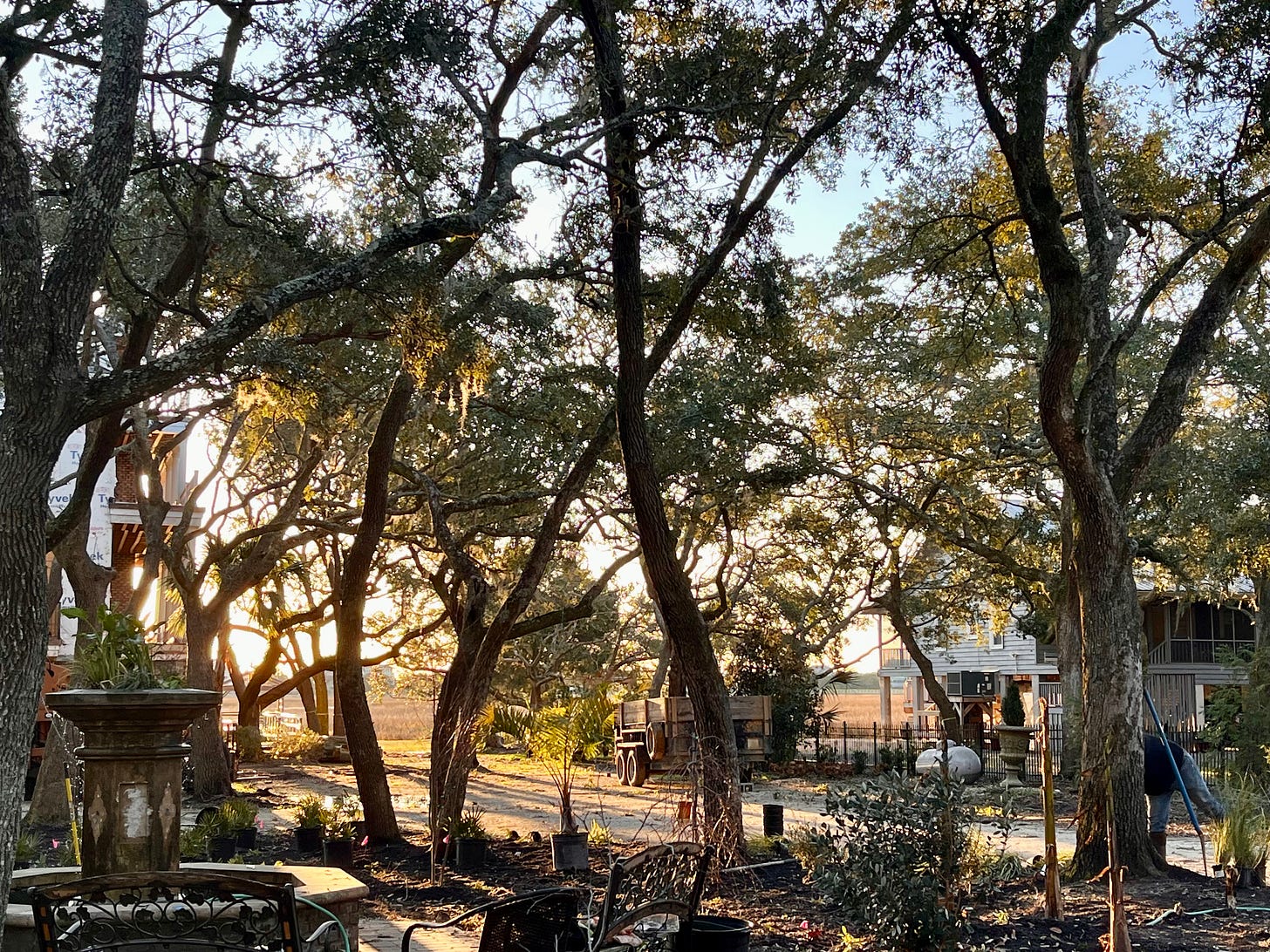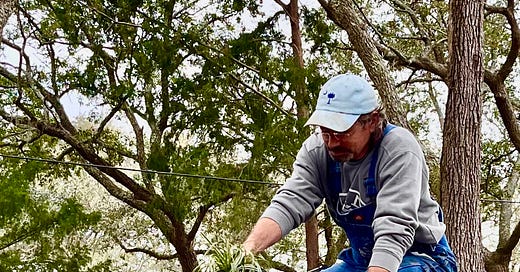We had a plan for this garden, but two weeks before installation, I flushed it all and started over. These last-minute changes without consulting the client couple. She likes real gardens, plant-driven gardens. Places that reflect and honor our Southern grandmothers’ tastes but with a modern flair. He’s an outdoorsy, athletic, hunter and fisher type, blond, rugged and refined. We had previously agreed on a design mantra. I did a garden design with this vision: a garden of large shrubs and meandering grass paths sort of like that famous Augusta golf course. But with cooler plants.
The football-field-sized space had two distinguishing features already. First, an amazing, cathedral-like canopy of live oak limbs. The trunks make sinuous black lines from ground to sky. Their horizontal limbs hung like black rafters, holding up a thin canopy. The trees define the space as a perfect habitat for southern garden favorites: azaleas, camellias, and hydrangeas. Second, a stiff, too-cute fountain that looked like it came from some Hollywood movie set for an old Spanish Zorro film.
The plants were ordered and the plan laid, the trucks and equipment and men all scheduled, and we even had a plan for the fountain.
But then came the flood. Client-man sent a video in which waves crashed through what would soon be the garden. A king tide during a storm. In it, he seems to be standing, rugged as he is, in rubber waist boots, taking a video of a saltwater flood. I knew immediately all the plants had to be switched out for salt-tolerant species.
Often, we humans put way too much emphasis on time. The fact that the flood came two weeks before doesn’t really matter in the large scheme of things. For this living land, for these oaks and that marsh, our calendars would seem ridiculously short. The plants in the marsh tolerate salt water all day long and have for millennia. The oaks tolerate infrequent flooding. These plants and that salt water are one living entity evolved together. It’s happened here before, and it will happen again.
We are living through a drastic change in the frequency of that flooding. Of course, we are part of the reason for that change. I can already see that the flooding is impacting the health of these five oaks. Many of them are weak and probably slowly dying.
Because of our short attention and time, we can’t really answer the question of whether this sort of dying-off has happened before. In a span longer than our lives, two weeks doesn’t really matter. I wish I could stop the change because I like the marsh, the oaks, and the maritime habitat as I know it.
What matters is that this land floods during a king tide. What I can do is make sure our garden plans fit into the system—and make the client love the space even more than they already do.
As to the second feature, the ostentatious fountain, there were a few options. How can we make something built with modern materials fit into an ancient grove of oaks?
We talked about tearing it down. But the expansive space needed an anchor, a structure to divide it, and at least a seating area for someone to stop and sit for a phone call. I went through lots of schemes to make it fit into the new garden finally settling on trying to make it age rapidly. It would look like something that had been in the woodland for years. Something trees had grown up around, hugging it, developing it, taking it back.
We would turn this into a ruin.
The first step was to cut the top off and certain offending parts. Then, fill the column with gravel. Then, plant water-loving plants. We re-plumbed the whole thing so that water flowed and trickled from many places. Water now cascades through the plants and dribbles over the edges. We painted on a moss and buttermilk mixture to help algae grow in those dribbles. We inoculated the whole thing.
It’s an old garden trick. But there is a new and trendy term for it. It’s called creating a bio-crust—encouraging life to grow on a manmade surface. Recent research has shown that bio-crust is part of the mysterious longevity of the Great Wall of China.
The plants we’ve put in are young. That’s best for survival. We have strategically placed some things like azaleas and hydrangeas. The young guys, talented and dedicated men, will add mulch, protective fencing, and detail the garden, so maybe next week, we’ll share photos of that.
Here’s a little video and a list of plants that will grow in the flowing water, softening and aging the structure.
Plants that I know will work in flowing water include rain lilies, lizards’ tails, horse tails, Calla lilies, Dollar weed, and Acorus.
Plants that are a trial include dwarf crinum, orange river lily, pineapple lily, and carex.

Finding and fitting into “place” can be challenging. We don’t all have ancient habitats to immerse ourselves in. How do you find beauty and meaning? How do you make the journey into any “place”?
Join special guest, author, and ecologist Janisse Ray for a day-long workshop on our Beech Island farm. Click this Link for details and reservations.
Please share this post with friends who love gardens and plant people.





Jenks, I could watch TV shows all day of you putting in gardens. And I'm super-excited to be coming to the Funky Little Flower Farm in March. Lucky us. All of us.
Y’all work so hard|